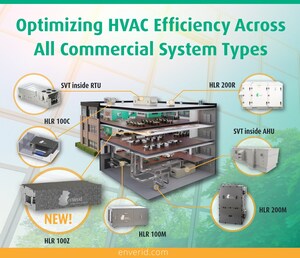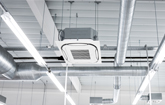WESTWOOD, Mass., Aug. 25, 2020 /PRNewswire/ -- enVerid Systems, a leading provider of indoor air quality solutions, fully supports the ASHRAE Epidemic Task Force's (ETF) updated guidance on HVAC strategies for mitigating the airborne transmission of COVID-19 in commercial buildings.
Released on August 17, 2020, ASHRAE's ETF refined its recommendations in its Commercial Guide, acknowledging the significant energy impact of pursuing a strategy of maximum outside air (OA) ventilation. enVerid and other experts have highlighted this as an area of concern. Research has shown that deploying high-efficiency filtration is as effective from a relative risk standpoint as increasing ventilation rates, but far less costly from an energy and system standpoint.
Key highlights from the updated ASHRAE ETF Commercial Guide:
- If there are significant energy impacts from increasing outside air for ventilation, use minimum outside air as required by Standard 62.1 with a minimum MERV-13 filter.
- If outdoor air quality is not healthy per Section 4 of Standards 62.1-2019, especially high particulate matters, do not open windows or increase ventilation without using the proper filters.
- Maintain relative humidity between 40% and 60% where possible.
- Consider portable air cleaners for conference rooms, private offices, and stairways; and when a room has insufficient outside air per code requirements and filtration is below MERV-13.
- Consider UVC light as an enhancement where spaces require additional measures, e.g. spaces that serve vulnerable occupants, or when MERV-13 filtration or 100% outside air are not possible.
"enVerid is pleased that ASHRAE's updated guidance takes into account the challenges of pursuing a maximum OA ventilation approach, particularly the substantial increase in energy expenditure it requires," said Christian Weeks, CEO of enVerid Systems. "Running a building has become significantly more expensive as owners and tenants put in place myriad upgrades to address COVID-19. With this new guidance, ASHRAE offers an alternative HVAC strategy with similar efficacy that will not add substantial costs to a building's already constrained operational budget."
During a June 18 presentation entitled the "Fundamentals of COVID-19 Risk Management," William Bahnfleth, professor of Architectural Engineering at The Pennsylvania State University and Chair of ASHRAE's Epidemic Task Force, cited research showing that the mean relative risk of infection can be reduced by filtration or by ventilation and that using filtration to achieve the same infection risk as an equivalent ventilation rate increase is much more cost effective. According to Professor Bahnfleth, "going from lower filter efficiency to higher filter efficiency leads to a significant reduction in infection risk with not much change in annual cost" and "achieving the same relative risk of infection using ventilation is much more costly, primarily due to the energy cost of increased ventilation rates."
"While building owners and tenants want to do everything in their power to mitigate the risk of transmission of COVID-19 in their commercial settings, the high costs and system impacts of maximum OA ventilation guidance were a major concern," said Robert Ioanna, Senior Principal at Syska Hennessy. "ASHRAE's updated guidance provides helpful clarification that using minimum outside air as required by ASHRAE 62.1 with MERV-13 or higher efficiency filters is the preferred approach when there are significant energy impacts from increasing outside air for ventilation and/or when there are concerns about humidity control or outdoor air quality."
According to Professor Max Sherman, an ASHRAE Distinguished Fellow and retired Senior Scientist at the Lawrence Berkeley National Laboratory, there are other benefits to increasing filtration. "Just maximizing outdoor air is not always the best strategy because there are energy and humidity consequences of doing that. Once you have the minimum amount of outdoor air, you want to minimize your exposure to the virus, and either more outdoor air or a filter can do that."
enVerid's HVAC Load Reduction (HLR) technology saves money for commercial property owners and institutions by enabling the reduction of outside air without compromising indoor air quality. HLR technology does this by scrubbing indoor air of all molecular contaminants of concern. ASHRAE Standard 62.1 defines two procedures for mechanical ventilation: the Ventilation Rate Procedure (VRP) and the Indoor Air Quality Procedure (IAQP). Unlike VRP, which defines ventilation requirements based on space size and occupancy without accounting for the efficiency benefits of air cleaning technologies, IAQP is a performance-based ventilation approach that allows for lower OA, and therefore lower energy expense when air scrubbing technology is used. Designing HVAC systems using IAQP combined with sorbent-based air cleaning and high-efficiency filtration significantly reduces first- and operating costs without increasing the risk of airborne transmission of viruses. For illustration, in a 100,000 ft2 office building in New York City, by reducing rather than increasing 10,000 CFM of OA, $500,000 can be saved on combined first costs and 20-year operating costs without increasing airborne virus transmission risk.
The new enVerid Air Purifier is a ceiling mounted, high-efficiency air filtration system with an ultraviolet germicidal irradiation (UVGI) sterilization lamp that has been shown to capture 99.99% of viruses including a surrogate for the COVID-19 virus. A low-cost, easy to install, and energy efficient solution, the enVerid Air Purifier is ideal for offices, classrooms, retail stores, and other commercial applications.
Weeks added, "We are gratified that ASHRAE's new recommendations are in alignment with the findings detailed in our recent white paper, specifically that OA ventilation adds material cost without significantly reducing the risk of airborne transmission. Of additional concern is that OA ventilation makes it more difficult to control humidity and increases the intake of particulate matter from polluted outside air - both factors that can exacerbate the severity of COVID-19 infection. We salute the tremendous dedication and thoughtfulness that the Epidemic Task Force has shown in the careful consideration of its recommendations."
About enVerid Systems, Inc.
enVerid Systems helps buildings achieve ESG (Environmental, Social, and Governance), healthy building, and cost saving goals by improving indoor air quality while saving money and reducing energy consumption and carbon emissions. For new HVAC systems, enVerid's award-winning HVAC Load Reduction (HLR) Modules enable immediate capital cost savings. HLR Modules also deliver up to 30% energy savings and superior indoor air quality in new and existing buildings. enVerid's air filtration products remove particulate and microorganism contamination from indoor air without the significant cost of upgrading mechanical systems and increasing mechanical ventilation rates. enVerid's products are deployed in commercial, academic, and government buildings globally. enVerid's HLR Modules are ASHRAE Standard 62.1, LEED, and WELL compliant and eligible for utility rebates. For more information please visit https://enverid.com.
Media Contact:
Heather Robb
[email protected]
978.985.7447
SOURCE enVerid Systems

Related Links
WANT YOUR COMPANY'S NEWS FEATURED ON PRNEWSWIRE.COM?
Newsrooms &
Influencers
Digital Media
Outlets
Journalists
Opted In



Share this article